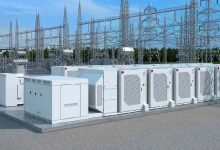Fluence, the battery technology joint venture between global energy giant Siemens and AES company says it has 800MW and 2,300MWh of battery storage orders as it unveils the latest version of its battery storage technology, which focuses on improved software and data capabilities and will lower costs.
Fluence has already built two big batteries in Australia – the already connected 30MW/30MWh Ballarat Energy Storage System in Victoria, located at a key network junction, and the soon-to-be commissioned 10MW/10MWh battery at the Lincoln Gap wind farm in South Australia.
It has also proposed giant twin batteries – 250MW each – to help expand the electric “highway” between Victoria and NSW, and as an alternative to traditional network-based upgrades or new links.
Fluence says the additions to the new battery storage system will help change the way the industry builds and scales storage, and delivers a modular form that scales easily with digital intelligence and provides the flexibility to meet dozens of different uses for storage – time shifting, frequency and voltage control, network support etc.
More importantly, the new technology stack will help drive down the non-battery costs of energy storage systems by up to 25 per cent, over and above the 90 per cent cost reductions in energy storage systems achieved over the last 12 years.
“By making energy storage simpler, more cost-effective and more scalable, Fluence’s technology will help customers deploy ever larger projects and fleets faster and more efficiently for less capital investment,” the company says.
The company is advocating for the use of battery storage as “virtual transmission” – such as the NSW-Victoria proposal – and also as “virtual dams”, using battery storage to add new capabilities and revenue opportunities for non-dispatchable hydro generation, such as run of river projects that have little control over their output.
You can listen to Fluence executives Jaad Clifford-Bolt and Achal Sondhi discuss this and other aspects of the new battery stack – and the global and Australian battery storage markets – in the latest episode of RenewEconomy’s popular Energy Insiders podcast.
The new battery stocks include three purpose-built systems, Gridstack, Sunstack and Edgestack that are configured for grid, renewable and commercial & industrial (C&I) applications, respectively.
“Energy storage applications require highly flexible systems that can be tailored to specific markets and customer needs,” said Fluence CTO Brett Galura. “
Until now, customers were forced to choose between custom-built solutions or inflexible, vertically integrated products. This sixth-generation technology combines our proprietary dataset – among the industry’s largest – and our deep industry experience to deliver unparalleled intelligence and flexibility, while adding the benefits of mass production to standardize safety features and significantly reduce the time and cost needed to deploy energy storage.”










